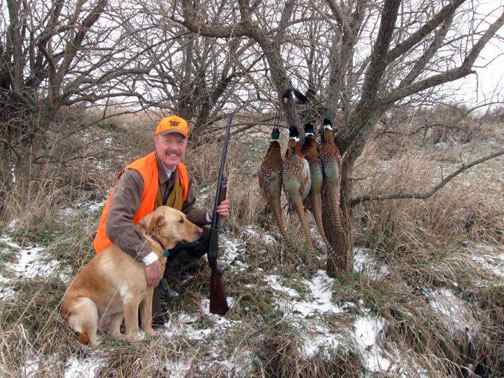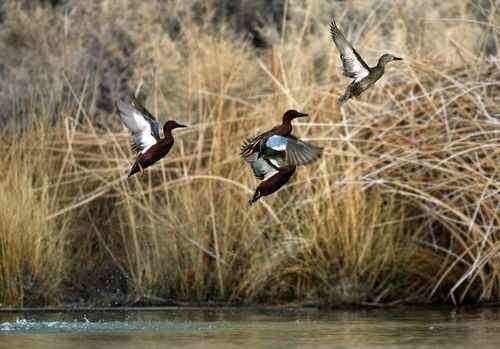Long Range Fish Report
From Sportfishing
From Sportfishing
Fish Report for 11-7-2013

DROUGHT CONTINUES TO FACTOR IN COLORADO PHEASANT/QUAIL HUNTING
11-7-2013
Colorado Parks & Wildlife
DENVER - Colorado Parks and Wildlife biologists say lingering effects of a two-year drought have significantly affected pheasant populations across eastern Colorado, setting up challenging conditions for upland bird hunters who take to the field for this Saturday's opener.
"Location will be very critical to hunting success again this year," said Ed Gorman, small game manager for Colorado Parks and Wildlife. While drought was severe across most of the core range, there are very small, distinct areas which received precipitation at a critical time. Generally speaking, across the range, nesting cover and brood habitat were severely limiting in 2013. Focus on areas that provided brood habitat.
East of I-25, Colorado's pheasant season runs through Jan. 31 2014. West of I-25, the season closes Jan. 5/
Northeast Colorado (including Yuma, Phillips, Sedgwick, Logan, Washington, Morgan and SE Weld Counties) hunters will see extreme impacts of drought in the fields this season, in terms of bird numbers and cover availability. There are still pheasants across much of the area, but densities are significantly lower than they were in 2010 and 2011. Typically, some areas weathered the drought better than others and will offer better success, although these areas will be localized and scattered. Many Walk-In Access (WIA) fields within the area have been hayed or grazed during the last two years, reducing cover quality significantly. All in all, biologists estimate bird numbers are no better than in 2012, and in some places may be further reduced. Early summer moisture allowed some hens to pull off late hatches, with the result that some areas will hold a few more birds than others.
With historic floods following severe drought, bobwhite quail populations in the South Platte River corridor (eastern Morgan, Washington, Logan and Sedgwick) are a huge question mark. Quality cover has been greatly reduced in the South Platte River in 2013. While some landowners have reported seeing some bobwhites after the flood, many more have not reported bobwhite observations.
Pheasant populations are much lower than their peak in 2011 and may be similar to 2012 in East Central Colorado (Southern Yuma, Kit Carson, Cheyenne, and Kiowa counties). Kit Carson County and southern Yuma County were terribly dry during the spring of 2013, reducing brood survival and recruitment significantly. Coupled with significant amounts of haying and grazing of CRP, drought has severely reduced the amount of habitat available for pheasants. Expect to find similar conditions in Cheyenne County. Pheasant densities will increase within the areas that provide sprinkler irrigation fields. Expect that populations are similar to last year, with localized declines or slight improvements possible.
Hunters should note that many areas in WIA in Kiowa County are enrolled primarily for their value for light goose hunting, including some fields that will offer little cover for pheasants and quail. Quail populations are present within the extreme southern reaches of this area, whereas few bobwhites or scaled quail exist in the northern counties of Kit Carson and Cheyenne.
Drought arrived earlier in extreme southeastern Colorado (Baca & Prowers), where pheasants and quail have suffered from drought since 2010. Conditions have improved this summer to nearly normal precipitation in some areas, but unfortunately most of precipitation that fell in the southeast occurred well after the primary nesting and brood rearing season. While wildlife managers have observed some localized late hatches of quail, populations are expected to be low in general. Hunters should also expect that pheasant populations will be low across the area, although a bit higher in areas with sprinkler irrigation systems.
Hunter Notes:
--Remember that extreme drought equals extreme fire danger when hunting in eastern Colorado.
--Hunting on private land requires permission. With the exception of land enrolled in Walk-In Access (Colorado Parks and Wildlife has leased WIA lands opening them to hunting), you must obtain permission to hunt private land, whether that land is posted or not.
--Landowners are very perceptive to the actions of hunters, whether on their land, WIA properties, or their neighbor's property. Trespassing, leaving trash, carcasses or damaging property leaves a poor image with landowners, while courteous and respectful hunting gives a good image
Small-game hunters in Colorado are also required to register for the Harvest Information Program (HIP) before hunting. Hunters can register and receive a HIP number by going on-line to http://www.colohip.com or by calling toll-free at 866-COLO-HIP (866-265-6447).
To read the entire pheasant/quail forecast, please visit: Department of Fish & Game Regulationshttp://wildlife.state.co.us/SiteCollectionDocuments/DOW/Hunting/SmallGame/PheasantQuailHuntingForecastandFAQ2013.pdf Read about one man's experiences with Colorado pheasant hunting in Colorado Outdoor's online: Department of Fish & Game Regulations http://coloradooutdoorsmag.com/2013/11/04/colorados-pheasant-season-nears/
"Location will be very critical to hunting success again this year," said Ed Gorman, small game manager for Colorado Parks and Wildlife. While drought was severe across most of the core range, there are very small, distinct areas which received precipitation at a critical time. Generally speaking, across the range, nesting cover and brood habitat were severely limiting in 2013. Focus on areas that provided brood habitat.
East of I-25, Colorado's pheasant season runs through Jan. 31 2014. West of I-25, the season closes Jan. 5/
Northeast Colorado (including Yuma, Phillips, Sedgwick, Logan, Washington, Morgan and SE Weld Counties) hunters will see extreme impacts of drought in the fields this season, in terms of bird numbers and cover availability. There are still pheasants across much of the area, but densities are significantly lower than they were in 2010 and 2011. Typically, some areas weathered the drought better than others and will offer better success, although these areas will be localized and scattered. Many Walk-In Access (WIA) fields within the area have been hayed or grazed during the last two years, reducing cover quality significantly. All in all, biologists estimate bird numbers are no better than in 2012, and in some places may be further reduced. Early summer moisture allowed some hens to pull off late hatches, with the result that some areas will hold a few more birds than others.
With historic floods following severe drought, bobwhite quail populations in the South Platte River corridor (eastern Morgan, Washington, Logan and Sedgwick) are a huge question mark. Quality cover has been greatly reduced in the South Platte River in 2013. While some landowners have reported seeing some bobwhites after the flood, many more have not reported bobwhite observations.
Pheasant populations are much lower than their peak in 2011 and may be similar to 2012 in East Central Colorado (Southern Yuma, Kit Carson, Cheyenne, and Kiowa counties). Kit Carson County and southern Yuma County were terribly dry during the spring of 2013, reducing brood survival and recruitment significantly. Coupled with significant amounts of haying and grazing of CRP, drought has severely reduced the amount of habitat available for pheasants. Expect to find similar conditions in Cheyenne County. Pheasant densities will increase within the areas that provide sprinkler irrigation fields. Expect that populations are similar to last year, with localized declines or slight improvements possible.
Hunters should note that many areas in WIA in Kiowa County are enrolled primarily for their value for light goose hunting, including some fields that will offer little cover for pheasants and quail. Quail populations are present within the extreme southern reaches of this area, whereas few bobwhites or scaled quail exist in the northern counties of Kit Carson and Cheyenne.
Drought arrived earlier in extreme southeastern Colorado (Baca & Prowers), where pheasants and quail have suffered from drought since 2010. Conditions have improved this summer to nearly normal precipitation in some areas, but unfortunately most of precipitation that fell in the southeast occurred well after the primary nesting and brood rearing season. While wildlife managers have observed some localized late hatches of quail, populations are expected to be low in general. Hunters should also expect that pheasant populations will be low across the area, although a bit higher in areas with sprinkler irrigation systems.
Hunter Notes:
--Remember that extreme drought equals extreme fire danger when hunting in eastern Colorado.
--Hunting on private land requires permission. With the exception of land enrolled in Walk-In Access (Colorado Parks and Wildlife has leased WIA lands opening them to hunting), you must obtain permission to hunt private land, whether that land is posted or not.
--Landowners are very perceptive to the actions of hunters, whether on their land, WIA properties, or their neighbor's property. Trespassing, leaving trash, carcasses or damaging property leaves a poor image with landowners, while courteous and respectful hunting gives a good image
Small-game hunters in Colorado are also required to register for the Harvest Information Program (HIP) before hunting. Hunters can register and receive a HIP number by going on-line to http://www.colohip.com or by calling toll-free at 866-COLO-HIP (866-265-6447).
To read the entire pheasant/quail forecast, please visit: Department of Fish & Game Regulationshttp://wildlife.state.co.us/SiteCollectionDocuments/DOW/Hunting/SmallGame/PheasantQuailHuntingForecastandFAQ2013.pdf Read about one man's experiences with Colorado pheasant hunting in Colorado Outdoor's online: Department of Fish & Game Regulations http://coloradooutdoorsmag.com/2013/11/04/colorados-pheasant-season-nears/
< Previous Report Next Report >
More Reports
Colorado Parks & Wildlife Reports
for Thursday, November 7th, 2013
• CHALLENGING PHEASANT SEASON BRINGS NEW OPPORTUNITY FOR STUDENT HUNTERS
• WATERFOWL HUNTING 101 SEMINAR IN DELTA COLORADO

10-31-2013
DENVER - Colorado Parks and Wildlife is seeking public input on the future management of the Mt. Evans elk herd...... Read More

LongRangeSportfishing.net © 2025. All Rights Reserved.
Website Hosting and Design provided by TECK.net
Website Hosting and Design provided by TECK.net